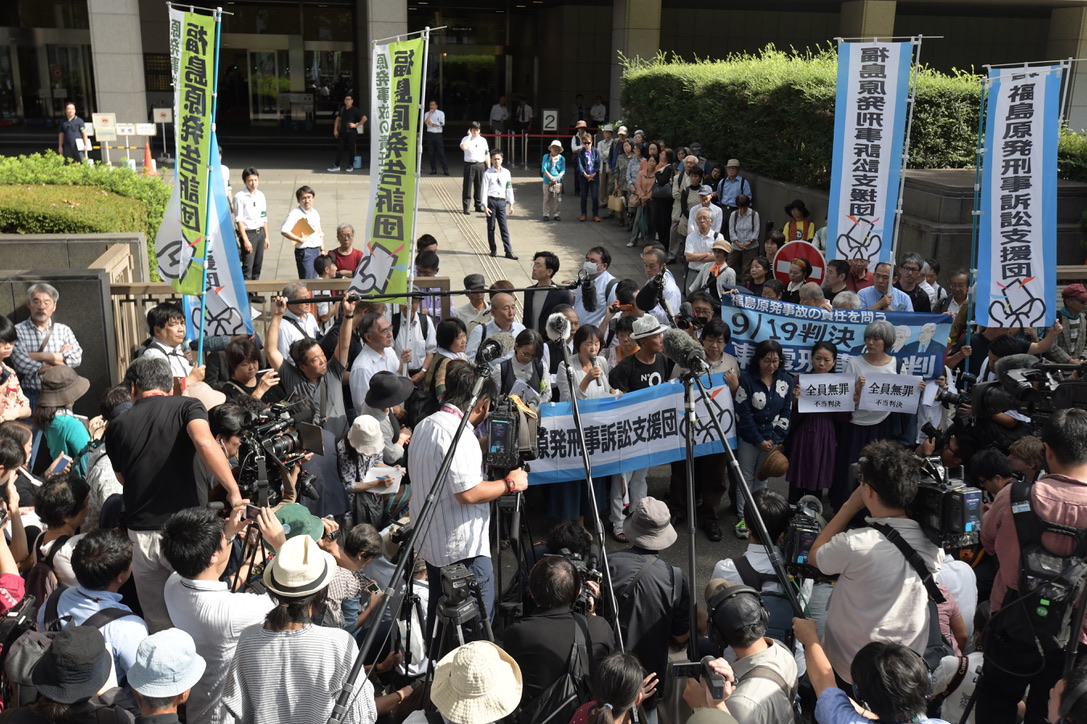Japanese legal system fails the victims of Fukushima Daiichi nuclear disaster ex-TEPCO executives found not guilty

Photo: Shaun Burnie
Tokyo, 19 September – The legal system of Japan has once again failed to stand up for the rights of tens of thousands of citizens impacted by the 2011 Fukushima Daiichi nuclear disaster, Greenpeace said today. The Tokyo District Court prosecutors, in the only criminal case brought by thousands of Fukushima and other Japanese citizens,(1) ruled that former CEO Tsunehisa Katsumata, and two former Executive Vice Presidents, Sakae Muto and Ichiro Takekuro, were not guilty in failing to take action that could have prevented the nuclear accident. This is despite evidence presented to the court that they were aware between 2002-2008 that there was a risk of a 15.7 meter tsunami hitting the Fukushima Daiichi nuclear plant.
“A guilty verdict would have been a devastating blow not just to TEPCO but the Abe government and the Japanese nuclear industry. It is therefore perhaps not a surprise that the court has failed to rule based on the evidence. More than eight years after the start of this catastrophe, TEPCO and the government are still avoiding being held to full account for their decades of ignoring the science of nuclear risks,” said Shaun Burnie, Senior Nuclear Specialist at Greenpeace Germany (based in Tokyo currently).
The Japanese nuclear industry continues to refuse to act on warnings of seismic hazards at their vulnerable reactor sites, not least TEPCO at its one remaining nuclear plant in Niigata.(2)
The court proceedings, which began in 2017, resulted from persistent efforts by a citizens panel to hold TEPCO to account. The court heard irrefutable evidence that TEPCO executives deliberately ignored evidence of major earthquake risks at the Fukushima Daiichi plant. Between 2002 and 2008, predictions of the potential of 15.7 meter tsunami were known to TEPCO. This was ten meters higher than the existing seawall at Fukushima Daiichi. TEPCO, struggling at the time with major financial losses due to the shutdown of the Kashiwazaki Kariwa reactors following the 2008 Niigata earthquake,(3) refused to invest in protective measures, including raising the seawall height and installing additional emergency generators.
“Deliberately ignoring scientific evidence of the multiple safety risks to Japanese nuclear plants was one of the principal reasons for the Fukushima nuclear disaster. It remains the default setting for the industry today. The people of Japan will be confronted with the dangerous legacy of the Fukushima accident for many decades ahead and longer, so today’s ruling, while a setback, is only part of a long road to justice for the citizens of Fukushima and Japan that will help to prevent another nuclear accident,” said Burnie
Notes:
1 – website of citizen’s support for the court case ;
– 2 -“Technical issues of Japanese seismic evaluations from the point of global and Japanese standards”, Satoshi Sato, Greenpeace Japan, 2015 and Katsuhiko Ishibashi, Emeritus Professor at Kobe University, seismologist, member of NAIIC (the National Diet of Japan Fukushima Nuclear Accident Independent Investigation Commission), presentation to Foreign Correspondents’ Club of Japan, April 27, 2015 – see https://www.youtube.com/watch?v=3nV018TVMec
3 – TEPCO’s Atomic Delusion: Greenpeace Japan, 25 June 2018, see https://www.greenpeace.org/japan/wp/wp-content/uploads/2019/08/3d2e8976-atomic_delusion.pdf